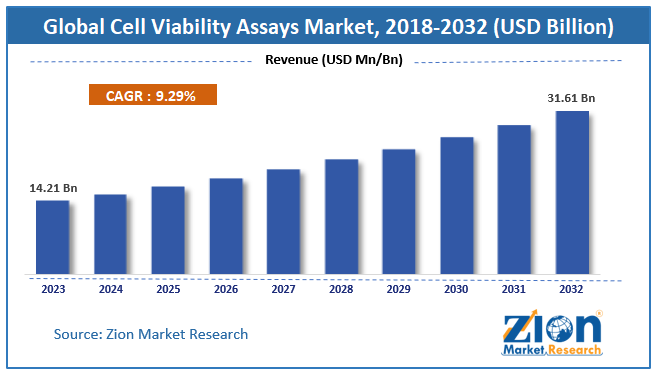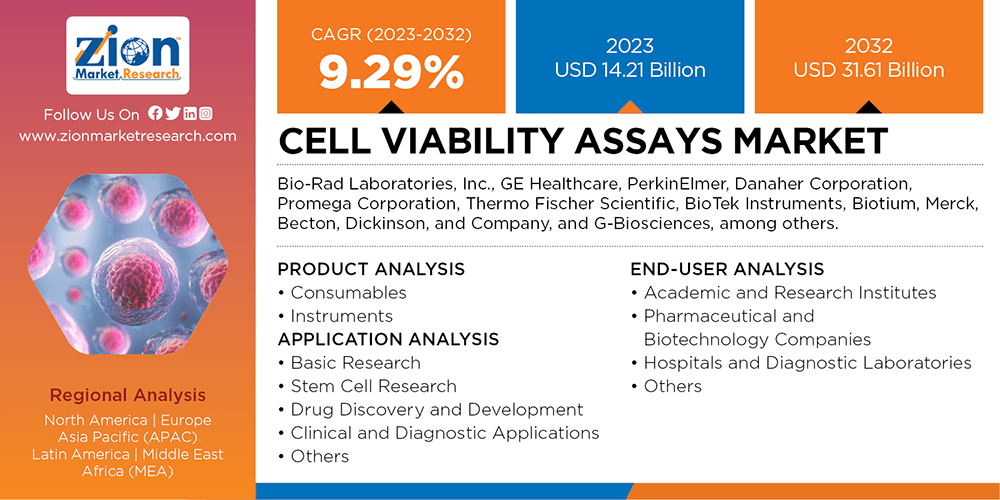Cell Viability Assays Market Size, Share, Analysis, Trends, Growth, 2032

Cell Viability Assays Market by Product (Consumables and Instruments), by Application (Basic Research, Stem Cell Research, Drug Discovery & Development, Clinical & Diagnostic Applications, and Others), and by End-User (Academic and Research Institutes, Pharmaceutical and Biotechnology Companies, Hospitals and Diagnostic Laboratories, and Others): Global Industry Perspective, Comprehensive Analysis, and Forecast, 2024-2032-
| Market Size in 2023 | Market Forecast in 2032 | CAGR (in %) | Base Year |
|---|---|---|---|
| USD 14.21 Billion | USD 31.61 Billion | 9.29% | 2023 |
Cell Viability Assays Industry Prospective:
The global cell viability assays market size was worth around USD 14.21 Billion in 2023 and is predicted to grow to around USD 31.61 Billion by 2032 with a compound annual growth rate (CAGR) of roughly 9.29% between 2024 and 2032.
The report analyzes the global cell viability assays market drivers, restraints/challenges, and the effect they have on the demands during the projection period. In addition, the report explores emerging opportunities in the cell viability assays industry.
The report covers a forecast and an analysis of the cell viability assays market on a global and regional level. The study provides historical data for 2018 and 2022 along with a forecast from 2023 to 2032 based on revenue (USD Billion). The study includes drivers and restraints of the cell viability assays market along with their impact on the demand over the forecast period. Additionally, the report includes the study of opportunities available in the cell viability assays market on a global level.
In order to give the users of this report a comprehensive view of the cell viability assays market, we have included a competitive landscape and an analysis of Porter’s Five Forces model for the market. The study encompasses a market attractiveness analysis, wherein all the segments are benchmarked based on their market size, growth rate, and general attractiveness.
Cell Viability Assays Market: Overview
For the purpose of determining the general health and function of cells, as well as the quantity of viable cells present in a sample, cell viability assays are experimental techniques that are utilized. Research in the fields of cell biology, pharmacology, toxicology, and drug development frequently make use of these assays in order to evaluate the impact of a variety of substances, therapies, or situations on the survival of cells.
Assessment of cell viability can be accomplished by a variety of approaches, each of which has its own set of benefits and drawbacks. Among the most popular forms of cell viability tests are the following:
Assay for the Exclusion of Trypan Blue: This test includes staining non-viable cells with Trypan Blue dye, which has the ability to penetrate cells that have membranes that have been damaged. However, non-viable cells are able to absorb the dye, which results in a blue coloration. Viable cells are able to avoid the dye. A microscope can then be used to count the cells that have not been labeled, which will allow for the determination of the number of live cells.
The 3-(4,5-dimethylthiazol-2-yl)-2,5-diphenyltetrazolium bromide (MTT) assay is performed as follows: The activity of the cells' metabolic processes is measured by this assay. In metabolically active cells, mitochondrial enzymes are responsible for the transformation of MTT, which is a yellow tetrazolium salt, into formazan crystals, which are purple in color. The formazan crystals are solubilized after a predetermined amount of time has passed during the incubation process, and the absorbance is then measured using spectrophotometry. A direct proportional relationship exists between the quantity of live cells and the intensity of the color that is generated.
Resazurin Assay: During the resazurin assay, metabolically active cells convert the non-toxic blue dye resazurin into the highly fluorescent resorufin. Resazurin is a cell-permeable dye. Quantification of the reduction of resazurin can be accomplished through the measurement of fluorescence or absorbance, with the signal intensity developing a correlation with the number of live cells.
LDH Assay (Lactate Dehydrogenase): LDH is a cytoplasmic enzyme that is released into the supernatant of the cell culture when the cell membrane is damaged. This release indicates that the cell has died or that it has been cytotoxic. This test determines the level of LDH activity in the supernatant, which serves as an indicator of the integrity of the cell membrane and the level of cytotoxicity.
Assessment of Adenosine Triphosphate (ATP): Adenosine triphosphate (ATP) is a substance that is found in every living cell and acts as a marker of the metabolic activity and survival of biological cells. It is possible to determine whether or not ATP is present through the use of luminescence-based technologies, with the signal intensity being proportional to the number of live cells.
These assays have the potential to offer researchers with vital information regarding the mechanisms of cell viability, proliferation, cytotoxicity, and cell death. This information enables researchers to analyze the effects of experimental treatments or conditions on the health of cells. Factors such as the exact research topic, the type of cell being tested, the experimental setting, and the resources that are available all play a role in determining which assay is the most suited.
The report provides company market share analysis to give a broader overview of the key players in the market. In addition, the report also covers key strategic developments of the market including acquisitions & mergers, new assay kits launch, agreements, partnerships, collaborations & joint ventures, research & development, and regional expansion of major participants involved in the market.
Cell Viability Assays Market: Growth Factors
The market for cell viability assays is seeing substantial expansion, which is primarily being driven by the growing demand across a variety of industries, including the pharmaceutical industry, biotechnology, and academic research. This expansion is being driven by a number of factors, one of which is the unrelenting search for innovative treatments, which calls for procedures that are both efficient and reliable for drug development and conducting toxicity testing.
In addition, developments in assay technologies, including as automation and high-content imaging, are contributing to the expansion of the market by increasing both the throughput and the accuracy of the measurement. Demand is further fueled by the growing prevalence of chronic diseases, which has led to an increased emphasis on personalized treatment and regenerative therapies, both of which are areas in which cell viability assays play of critical importance. Additionally, the increasing investments in bio sciences research around the world highlight the market's potential for continuous expansion, which promises sustained growth in the years to come.
Cell Viability Assays Market: Report Scope
| Report Attributes | Report Details |
|---|---|
| Report Name | Cell Viability Assays Market Research Report |
| Market Size in 2023 | USD 14.21 Billion |
| Market Forecast in 2032 | USD 31.61 Billion |
| Growth Rate | CAGR of 9.29% |
| Number of Pages | 255 |
| Forecast Units | Value (USD Billion), and Volume (Units) |
| Key Companies Covered | Bio-Rad Laboratories, Inc., GE Healthcare, PerkinElmer, Danaher Corporation, Promega Corporation, Thermo Fischer Scientific, BioTek Instruments, Biotium, Merck, Becton, Dickinson, and Company, and G-Biosciences, among others. |
| Segments Covered | By Product, By Application, By End-User, And By Region |
| Regions Covered | North America, Europe, Asia Pacific (APAC), Latin America, Middle East and Africa (MEA) |
| Base Year | 2023 |
| Historical Year | 2018 to 2022 |
| Forecast Year | 2024 - 2032 |
| Customization Scope | Avail customized purchase options to meet your exact research needs. Request For Customization |
Cell Viability Assays Market: Segmentation
The study provides a decisive view of the cell viability assays market on the basis of product, application, end-user, and region. All the segments have been analyzed based on present and future trends and the market is estimated from 2024 to 2032. The regional segment includes North America, Europe, Asia Pacific, Latin America, and the Middle East and Africa.
Cell Viability Assays Market: Competitive Players
Some key players of the global cell viability assays market are
- Bio-Rad Laboratories. Inc.
- GE Healthcare
- PerkinElmer
- Danaher Corporation
- Promega Corporation
- Thermo Fischer Scientific
- BioTek Instruments
- Biotium
- Merck
- Becton
- Dickinson, and Company
- G-Biosciences
- Among Others.
This report segments the global cell viability assays market as follows:
Global Cell Viability Assays Market: Product Analysis
- Consumables
- Assay Kits
- Tetrazolium Reduction Assay Kits
- Resazurin Cell Viability Assay Kits
- Calcein-AM Cell Viability Assay Kits
- Others
- Reagents
- Microplates
- Assay Kits
- Instruments
- Automated Cell Counters
- Spectrophotometers
- Cell Imaging and Analysis Systems
- Flow Cytometers
Global Cell Viability Assays Market: Application Analysis
- Basic Research
- Stem Cell Research
- Drug Discovery and Development
- Clinical and Diagnostic Applications
- Others
Global Cell Viability Assays Market: End-User Analysis
- Academic and Research Institutes
- Pharmaceutical and Biotechnology Companies
- Hospitals and Diagnostic Laboratories
- Others
Global Cell Viability Assays Market: Regional Analysis
- North America
- U.S.
- Europe
- UK
- France
- Germany
- Asia Pacific
- China
- Japan
- India
- Latin America
- Brazil
- Middle East and Africa
Table Of Content
Methodology
FrequentlyAsked Questions
A cell viability assay measures the amount of healthy, living cells in a sample and their health. These assays are crucial in biomedical research, medicines, and toxicology. Researchers can assess cell survival and function after experimental treatments, medications, or environmental variables by evaluating cell viability. Assays measure metabolic activity, membrane integrity, and cellular ATP. MTT, trypan blue exclusion, and ATP tests are common and offer different benefits depending on the study needs. In general, cell viability assays are essential to understanding cellular responses in many biological situations.
Chronic diseases are on the rise, requiring more efficient drug research and development, where cell viability assays are vital.
According to the report, the global cell viability assays market size was worth around USD 14.21 billion in 2023 and is predicted to grow to around USD 31.61 billion by 2032.
The global cell viability assays market is expected to grow at a CAGR of 9.29% during the forecast period.
Some key players of the global cell viability assays market are Bio-Rad Laboratories, Inc., GE Healthcare, PerkinElmer, Danaher Corporation, Promega Corporation, Thermo Fischer Scientific, BioTek Instruments, Biotium, Merck, Becton, Dickinson, and Company, and G-Biosciences, among others.
The global cell viability assays market report covers the geographical market along with a comprehensive competitive landscape analysis. It also includes cash flow analysis, profit ratio analysis, market basket analysis, market attractiveness analysis, sentiment analysis, PESTEL analysis, trend analysis, SWOT analysis, trade area analysis, demand & supply analysis, Porter’s five force analysis, and value chain analysis.
Choose License Type
RelatedNews
HappyClients
Zion Market Research
Tel: +1 (302) 444-0166
USA/Canada Toll Free No.+1 (855) 465-4651
3rd Floor,
Mrunal Paradise, Opp Maharaja Hotel,
Pimple Gurav, Pune 411061,
Maharashtra, India
Phone No +91 7768 006 007, +91 7768 006 008
US OFFICE NO +1 (302) 444-0166
US/CAN TOLL FREE +1 (855) 465-4651
Email: sales@zionmarketresearch.com
We have secured system to process your transaction.
Our support available to help you 24 hours a day, five days a week.
Monday - Friday: 9AM - 6PM
Saturday - Sunday: Closed







